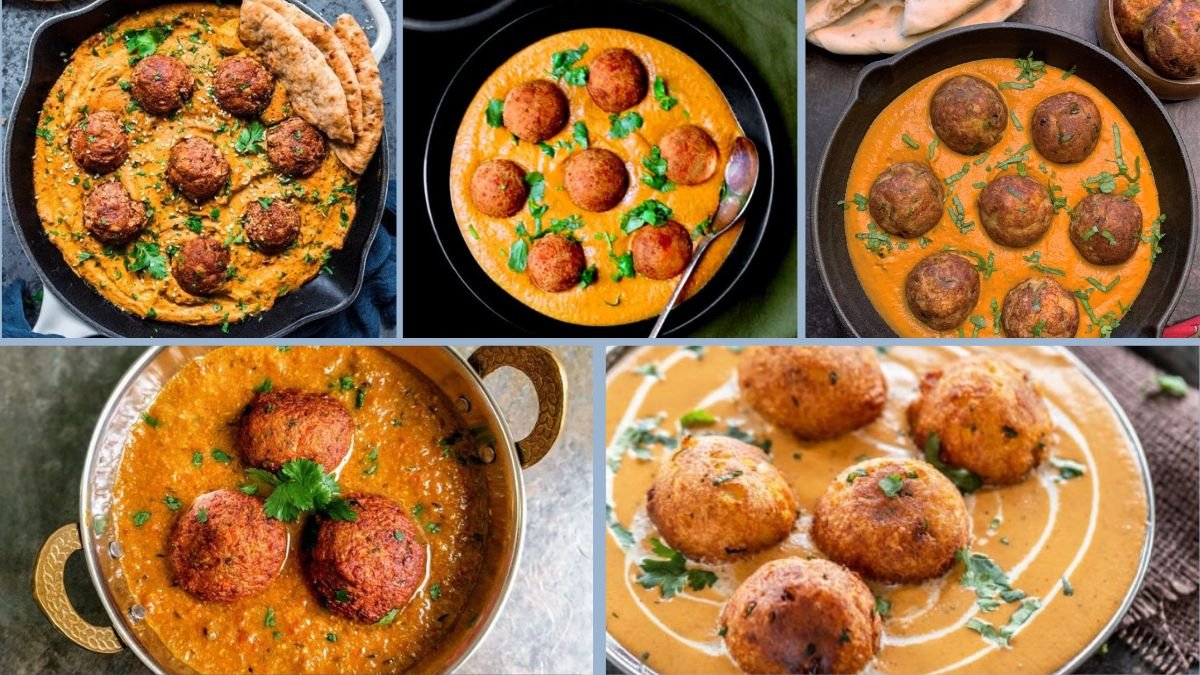Kofta curry is a classic and crowd‑pleasing dish in Indian and Middle Eastern cuisines. Typically, koftas (vegetable or meat dumplings) are deep‑fried and then soaked into a rich gravy. While delicious, deep frying increases fat and calorie content, which may conflict with health‑oriented, low‑oil, or dietetic meal planning.
This article presents a structured 6‑step recipe for Vegetable Kofta Curry without frying. The method aims to preserve flavor and texture while reducing oil usage. This is especially relevant in nutritional studies, culinary innovation, and diet‑friendly recipe design.
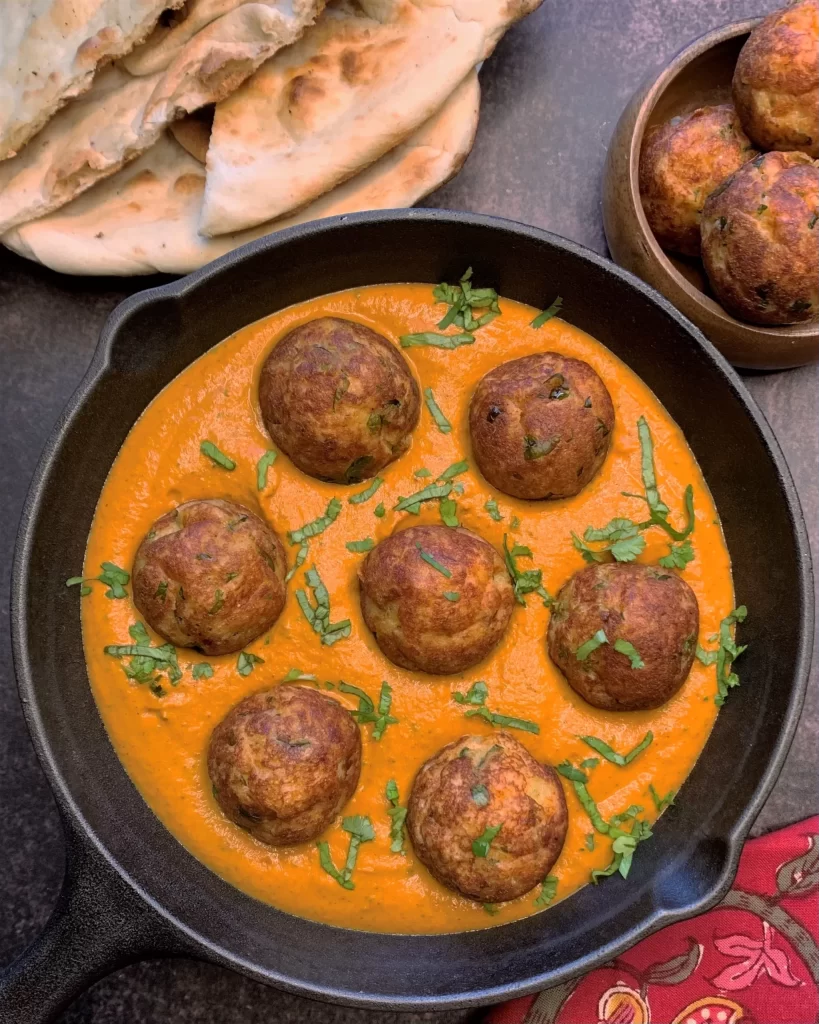
The six steps are:
- Ingredient selection & preparation
- Making the kofta mixture & shaping
- Cooking koftas by alternative method (steaming, baking, or pan roasting)
- Preparing the curry (gravy)
- Integrating kofta into curry & simmering
- Garnishing, serving, storage & troubleshooting
Let’s go through them in detail.
Step 1: Ingredient Selection & Preparation
Careful selection and pre‑preparation of ingredients lay the foundation for success.
A. Vegetables & fillers for kofta
Choose firm, low‑moisture vegetables to minimize sogginess:
- Carrot (grated)
- Cauliflower florets (finely chopped or lightly steamed)
- Green peas (lightly boiled)
- Capsicum / bell pepper (finely diced)
- Beans / green beans (finely chopped)
- Potato (boiled, mashed, small proportion) — for binding
- Onion & garlic / ginger (optional) — your preference
- Fresh coriander leaves, green chili, spices (cumin, garam masala, red chili powder)
Squeeze excess moisture from vegetables (especially cauliflower, peas, and capsicum). This helps the koftas hold shape.
B. Binding agents & dry ingredients
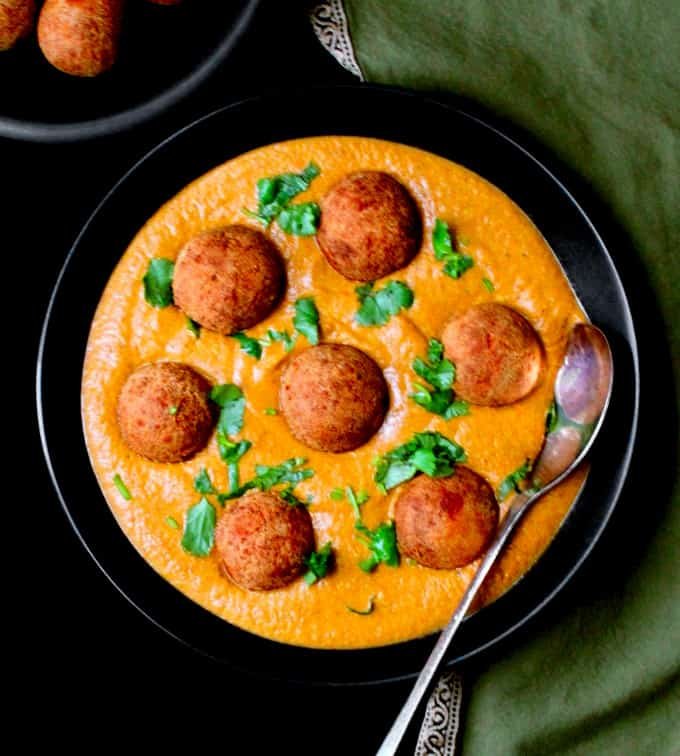
- Gram flour (besan) or chickpea flour — main binder
- Cornstarch / cornflour (small amount) — for extra binding
- Bread crumbs or rusk powder (dry coating if needed)
- Salt and dry spices (turmeric, red chili, coriander powder, cumin powder)
C. Gravy (curry) base ingredients
- Tomatoes, pureed or chopped
- Onion, garlic, ginger (if using)
- Cashews or cashew paste (for creaminess)
- Whole spices: cumin seeds, bay leaf, cardamom, cloves, cinnamon
- Spice powders: turmeric, coriander, red chili, garam masala
- Water / vegetable stock
- Kasuri methi (dried fenugreek leaves)
- Fresh coriander for garnish
Once all ingredients are measured and prepped (vegetables cleaned, chopped, squeezed, spices ready, cashews soaked), you’re ready to begin mixing.
Step 2: Making the Kofta Mixture & Shaping
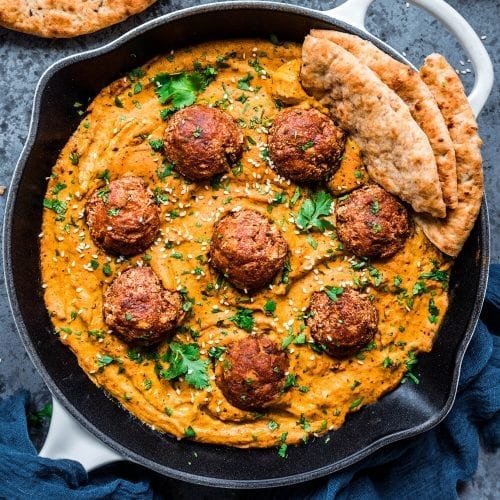
Here you combine vegetables and binders to form dumpling shapes.
- In a bowl, mix the squeezed vegetables along with mashed potato (if used), coriander, finely chopped green chilies, ginger‑garlic (if using), salt, and spices (cumin powder, red chili, garam masala).
- Add gram flour (besan) gradually and begin mixing. If the mixture feels too soft or sticky, add a bit of cornstarch or bread crumbs. The goal is a consistency that can be shaped into balls without falling apart.
- Taste a tiny portion (raw, uncooked) for seasoning and adjust salt/spices.
- Shape the mixture into small kofta balls or oval dumplings (roughly 1 to 1½ inch diameter).
Some recipes (like Vegetable Malai Kofta Curry – non fried) skip deep frying by baking or pan roasting.
Also, in some “no fry” kofta recipes, people bake the koftas and then add to gravy.
Alternative shaping/coating options:
- Roll each kofta in dry bread crumbs or semolina — gives a light crust when cooked.
- Use an oven or air fryer for light browning.
- Or use a nonstick, heavy‑bottomed pan to roast with minimal oil (just a spray or smear).
Let the shaped koftas rest for 5–10 minutes so binding sets.
Step 3: Cooking Koftas Without Frying
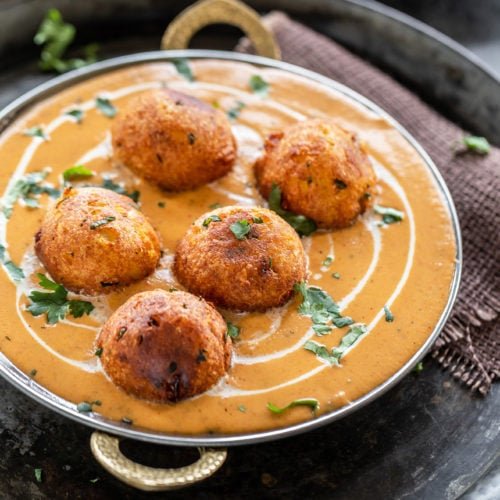
Here are some healthier options to cook koftas without deep frying:
Option A: Baking / Oven Roasting
- Preheat oven to ~200 °C (≈400 °F).
- Place koftas on a greased or parchment-lined baking sheet.
- If desired, lightly brush or spray a few drops of oil (not mandatory).
- Bake for ~15–20 minutes, flipping once halfway for even browning.
Option B: Pan/Roasting on Nonstick / Grill Pan
- Use a good nonstick skillet or cast iron pan.
- Heat it on medium-low heat.
- Place koftas, cover with a lid, and roast, turning occasionally, until all sides get a light golden crust.
- Optionally, you can smear just a little bit of oil on pan surface (minimal).
Option C: Steaming / Partial Cooking + Finishing in Gravy
- Steam the koftas lightly (5–6 minutes) so they bind and firm up.
- Then add to hot curry and let them finish cooking in the gravy (they soak flavors).
- This method ensures no frying at all, though you might lose exterior crust.
In many non-fried recipes, the koftas are baked or pan-cooked and then added into the curry.
Once koftas are cooked (baked, roasted, or steamed), keep them aside.
Step 4: Preparing the Curry (Gravy)
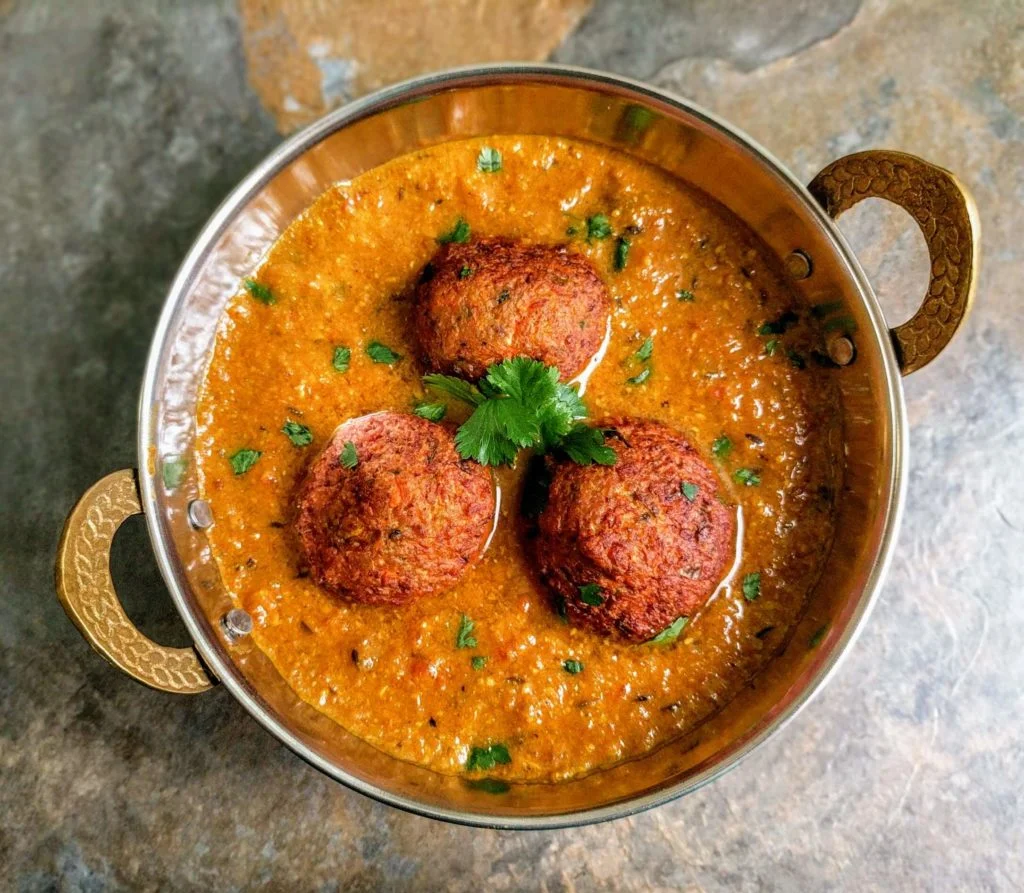
While koftas are cooking, prepare the flavorful curry base.
- In a heavy-bottomed pan, heat 1 teaspoon oil (or use water sauté technique) and crackle some cumin seeds, along with whole spices (bay leaf, cinnamon, cardamom, cloves).
- Add onion, garlic, ginger paste (if using) and sauté until translucent.
- Add tomato puree (or chopped tomatoes), cook until oil separates or raw smell goes away.
- Add spice powders — turmeric, coriander powder, red chili powder — along with salt. Roast gently on low flame.
- Add cashew paste or blended cashews + a little water to provide creaminess. Some recipes make cashew paste with onions and tomatoes too.
- Add water or vegetable stock to adjust consistency; simmer for a few minutes.
- Add kasuri methi and garam masala toward the end.
- Check seasoning and balance (spice, salt, tang) before adding koftas.
Use gentle simmering to let flavors develop. Do not overboil.
Step 5: Integrating Kofta into Curry & Final Simmering
This is where the koftas meet the gravy.
- Gently add the cooked koftas into the simmering curry, one by one, without stirring vigorously (to avoid breaking them).
- Cover and let them simmer in the curry for 5–7 minutes so they absorb flavors.
- If the gravy thickens too much, add a little hot water and gently swirl.
- Taste again and adjust salt or spices.
- Turn off heat and let rest for a minute or two before serving.
This final step ensures the koftas soak flavors and the overall dish harmonizes.
Step 6: Garnishing, Serving, Storage & Troubleshooting
Garnishing & Serving Suggestions
- Garnish with fresh chopped coriander leaves.
- Optionally, drizzle a little cashew cream or malai (if vegetarian dairy) on top.
- Serve hot with rotis, naan, steamed rice, or jeera rice.
- For festive touch, you can add julienned ginger or julienned green chili as a garnish.
Storage & Reheating
- Refrigeration: Store leftover kofta curry in airtight containers for up to 2 days.
- Reheating: Gently reheat on stovetop; avoid vigorous boiling (koftas may disintegrate).
- Freezing: Possible, but koftas may soften; advisable to freeze curry and koftas separately if needed.
Troubleshooting & Tips
| Issue | Likely Cause | Remedy |
|---|---|---|
| Koftas fall apart | Too much moisture, insufficient binder | Squeeze vegetables, increase besan / cornflour |
| Koftas soggy in gravy | Cooked too early, soaked too long | Add them last, simmer gently |
| Bland curry | Under-seasoned, insufficient roasting of spices | Roast spices well, adjust salt & chili |
| Gravy too thick | Insufficient liquid | Add hot water / stock |
| Gravy too thin | Too much water or under-reduced | Simmer uncovered to reduce |
Sample Approximate Recipe (for 4 servings)
Koftas:
- Carrot: ½ cup, grated
- Cauliflower: ½ cup, finely chopped & squeezed
- Green peas: ¼ cup, lightly mashed
- Capsicum: ¼ cup chopped
- Boiled potato: 1 small, mashed
- Coriander, green chili, ginger‑garlic paste (optional)
- Salt, cumin powder, red chili, garam masala
- Besan: ⅓ cup
- Cornstarch / breadcrumbs: ~1–2 tbsp
Curry (Gravy):
- Onion: 1 medium
- Tomato puree: 1½ cups
- Cashews: 10–12, soaked & ground
- Cumin seeds, bay leaf, cardamom, cloves
- Turmeric, coriander powder, red chili powder
- Garam masala, kasuri methi
- Salt, water / stock
- Fresh coriander to garnish
Follow the six steps above with these quantities. Bake or roast koftas, make gravy, combine, simmer, garnish, and serve.
Advantages, Nutritional Significance & Academic Notes
- Reduced fat and calories compared to deep-fried versions
- Better suitability for dietetic or low-fat meal plans
- Retention of vegetable nutrients due to gentle cooking
- The study of binding agents, moisture content, texture, and flavor absorption offers scope for food science research
- Sensory evaluation (appearance, aroma, texture, flavor) can compare traditional vs non‑fried versions
Conclusion
This 6‑Step Recipe for Vegetable Kofta Curry without frying demonstrates how classic, indulgent dishes can be adapted into healthier, vegetarian versions without losing their appeal. With careful ingredient selection, strategic cooking techniques, and flavor balancing, one can achieve a dish that is:
- Delicious and aromatic
- Health‑friendly (reduced oil)
- Suitable for varied dietary needs
- Valuable as a case study in culinary innovation
If you like, I can also convert this into a formatted thesis chapter (with figures, tables, sensory evaluation plan) or a shorter abstract. Would you like me to do that?.
